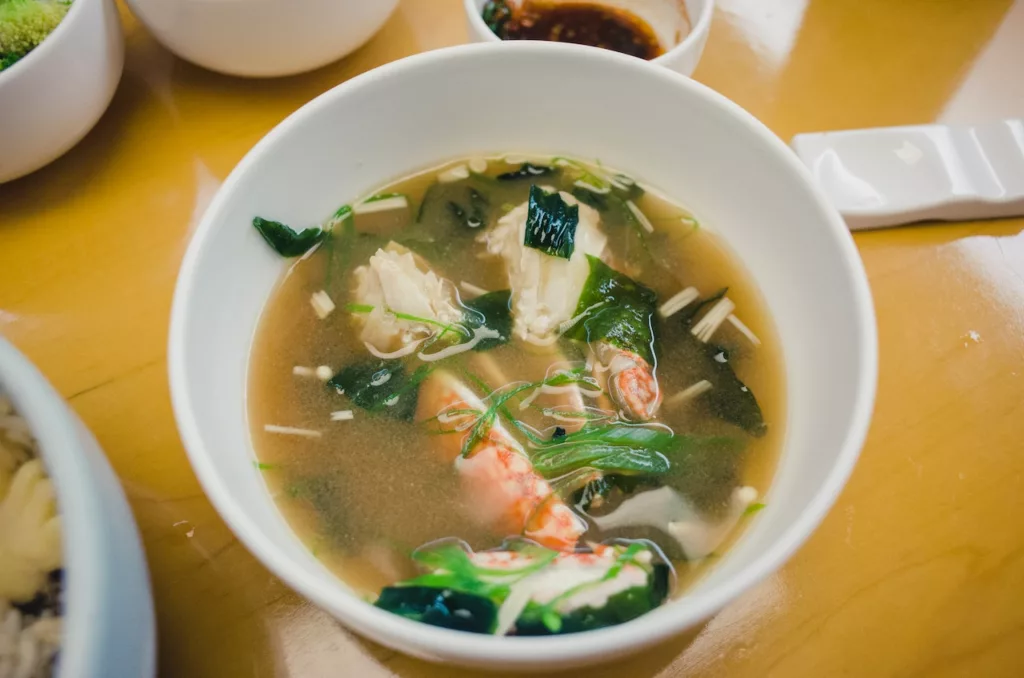Miso soup is also called omiotsuke in Japanese. Miso soup and suimono are two main soup recipes that form the basis of Japanese cuisine. It belongs to the traditional Japanese recipe prepared by mixing the dashi stock with softened miso paste. Apart from dashi stock and miso paste as the main ingredients, miso soup may contain vegetables, tofu, seaweeds, etc., all optional ingredients added according to seasonal availability and personal choices and preferences.

Every continent and country has its own culture concerning clothes, jewelry, food, and many others. According to the Japanese food culture, miso soup is considered to represent the soup dishes served along with rice. The soybeans are fermented with salt and the fungus Aspergillus oryzae to make the authentic miso paste. The fermented soybeans are a rich source of amino acids and give an umami flavor to the soup that aids in filling up the stomach quickly and provides a calorie-controlled diet.
Other ingredients such as rice, barley, and others are sometimes used while preparing the miso paste. The paste can be divided into three categories: white miso, fermented for a shorter period, lighter on the meal, and sweet to taste, while there is a longer fermenting time for red miso, which has a strong flavor. The mixed one is a combination of flavors from white and red miso. The dashi stock for miso soup is cooked by combining dried baby sardines, dried kelp, thin shavings of dried and smoked bonito, or dried shiitake.
Gluten is a mixture of wheat, barley, oats, and rye proteins. This gluten-rich diet may lead to gastrointestinal symptoms and other systemic disorders for some people who suffer from gluten ataxia, wheat allergy, celiac disease, or non-celiac gluten sensitivity.
Apart from having a delectable flavor, researchers in 2003 claimed that consuming at least three or more bowls of miso soup could lower the risk of breast cancer in women. The studies done on the health benefits of miso soup in 2020 have shown that regular consumption helps maintain blood pressure and heart rate and also aids in preventing constipation due to the proliferation of good bacteria into the intestine.
Miso soup is quite effective for people who want to lose weight or practice a healthy diet. Miso soup accounts for only 40 calories if it contains only miso paste and dashi stock as the ingredient. The calories count to about 60 calories if, in addition to miso paste and dashi stock, miso soup is loaded with green onions and tofu. The calorie count can still rise if potato, seafood, and other ingredients are added to the bowl of miso soup.
Nutrients in miso soup
According to nutritionists and health care experts, there are plenty of nutritional benefits if you consume miso soup regularly. The ingredients in the miso soup make it a bowl packed with nutrients, minerals, and proteins, including nine essential amino acids. Apart from this, miso soup also consists of Vitamin B, E, Vitamin K, and other dietary fibers that help maintain the health of the digestive system and provide additional health benefits to the body.

Substances like isoflavone, choline, and lecithin help improve memory and concentration power, increase the levels of good HDL (high-density lipoproteins) cholesterol, and decrease the levels of bad LDL (low-density lipoproteins) cholesterol, thus maintaining the fat metabolism as well as liver function. Heart health, the skin’s health, and the hair’s shine improve a lot after regular consumption of lecithin in your diet. The sugar is present but in a meager amount of about 3 gm per bowl of miso soup to pride no harmful effect on the body.
Miso soup provides certain health benefits, such as preventing cancer cells from developing in the body, preventing aging, and protecting the body cells from radiation damage. Salt in the miso soup is present in very low amounts of about 1.2 gm per cup and hence, does not affect blood pressure. It aids in suppressing the blood pressure that counteracts the effects of salt in the miso soup.
Conclusion
Several soups are available, including chicken soup, mixed vegetable soup, and many others that add much nutritional value to our diet. The soups keep us hydrated, are low in calories, and thus are good for our health and help us lose weight.
Miso soup is an authentic Japanese cuisine that provides a healthy option for people with low-calorie counts. This blog has highlighted the nutritional benefits of miso soup.
Do let us know your experience in the comment section below.


















